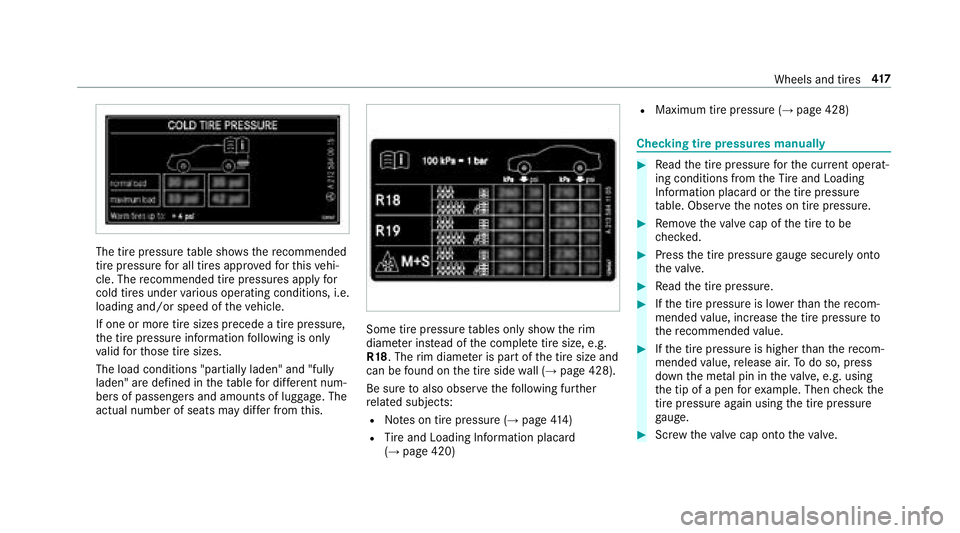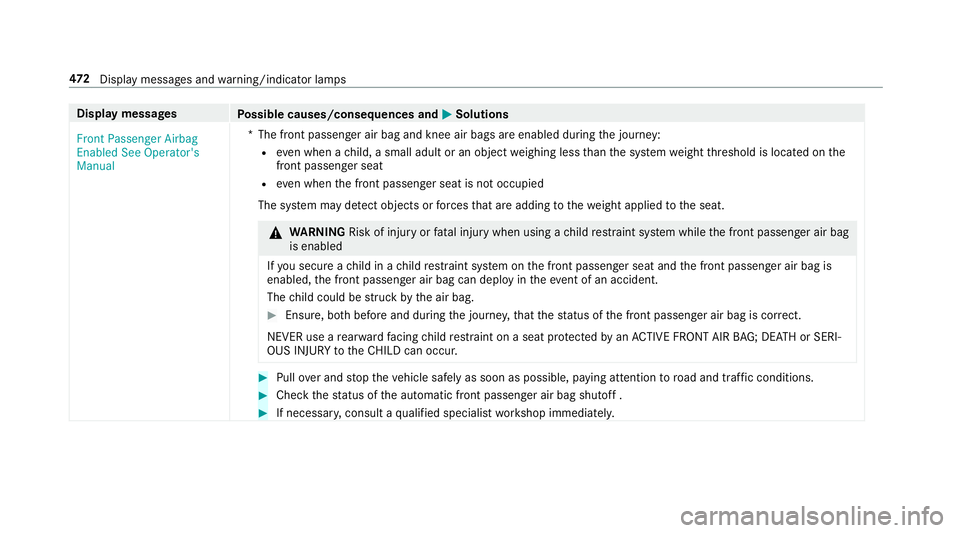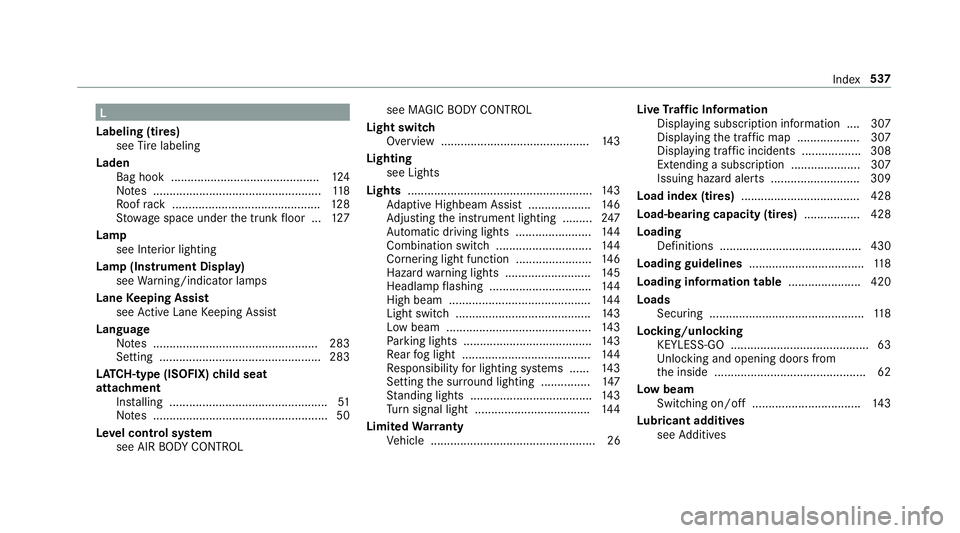2018 MERCEDES-BENZ S-CLASS SEDAN ECU
[x] Cancel search: ECUPage 412 of 562

Electrical fuses
Notes on electrical fuses
&
WARNING Risk of accident and injury
due to ov erloaded lines
If yo u man ipulate orbridg e afaulty fuse or if
yo ure place it with a fuse with a higher
amperage, the electric line could be overloa‐
ded.
This could result in a fire .
#Alw aysre place faulty fuses with speci‐
fi ed new fuses conta iningthe cor rect
amperage.
* NO
TEDama gecaused byincor rect fuses
Incor rect fuses may cause damage toelectri‐
cal components or sy stems.
#Only use Mercedes-Benz appr oved
fuses with the cor rect fuse rating.
Blown fuses must bereplaced with fuses of the
same rating, which you can recognize bythe
color and fuse rating. The fuse ratings are li sted in
the fuse assignment diagram. The fuse assign‐
ment diagram is in theve hicle document wallet.
* NO
TEDama geor malfunctions caused
by moisture
Moisture may cause dama getothe electrical
sy stem or cause it tomalfunction.
#When the fuse box is open, make sure
th at no moisture can enter the fuse
box.
#When closing the fuse box, make sure
th at the seal of the lid is positioned cor‐
re ctly on the fuse box.
Ifth e newly inser ted fuse also blo ws, ha vethe
cause traced and rectified at a qualified special‐
ist workshop, e.g. an authorized Mercedes-Benz
Center.
Ensure thefo llowing before replacing a fuse:
RThe vehicle is secured against rolling away.
RAll electrical consumers are switched off.
RThe ignition is switched off. The electrical fuses are located in
various fuse
bo xes:
RFu se box in the engine compartment on the
driver's side (→page 410)
RFu se box on the driver's side of the dash‐
board (→page 412)
RFu se box in the front-passen gerfo ot we ll
(→page 412)
RFu se box in the trunk on theright-hand side
of theve hicle, when vie wed in the direction
of tra vel (
→page 412)
Fu se box in the engine compa rtment
Requ irements:RObser vethe no tes on electrical fuses
(→page 410).
Ha ve thefo llowing readily available:
RA dry clo th
RA screwdriver
410
Breakdown assis tance
Page 419 of 562

The tire pressuretable sho ws there commended
tire pressure for all tires app rove dfo rth is vehi‐
cle. The recommended tire pressures apply for
cold tires under various operating conditions, i.e.
loading and/or speed of theve hicle.
If one or more tire sizes precede a tire pressure,
th e tire pressure information following is only
va lid forth ose tire sizes.
The load conditions "partially laden" and "fully
laden" are defined in theta ble for dif fere nt num‐
be rs of passengers and amounts of luggage. The
actual number of seats may dif fer from this.
Some tire pressure tables only show therim
diame ter ins tead of the comple tetire size, e.g.
R18 . The rim diame ter is part of the tire size and
can be found on the tire side wall (
→page 428).
Be sure toalso observ eth efo llowing fur ther
re lated subjects:
RNo tes on tire pressure (→page 414)
RTire and Loading Info rmation placard
(→page 420)
RMaximum tire pressure (→page 428)
Checking tire pressure s manually
#Read the tire pressure forth e cur rent operat‐
ing conditions from theTire and Loading
Info rmation placard or the tire pressure
ta ble. Obser vethe no tes on tire pressure.
#Re mo vetheva lve cap of the tire tobe
ch ecked.
#Press the tire pressure gauge securely onto
th eva lve.
#Re ad the tire pressure.
#Ifth e tire pressure is lo werth an there com‐
mended value, inc rease the tire pressure to
th ere commended value.
#Ifth e tire pressure is higher than there com‐
mended value, release air. Todo so, press
down the me tal pin in theva lve, e.g. using
th e tip of a pen forex ample. Then check the
tire pressure again usingthe tire pressure
ga uge.
#Sc rew theva lve cap onto theva lve.
Wheels and tires 41
7
Page 434 of 562

these are ins talled on theve hicle, but does not
include passengers or luggage.
Maximum tire load: the maximum tire load is
th e maximum permissible weight in kilog rams or
lbs for which a tire is appr oved.
Maximum permissible tire pressure: maxi‐
mum permissible tire pressure for one tire.
Maximum load on one tire: maximum load on
one tire. This is calculated bydividing the maxi‐
mum axle load of one axle bytwo.
PSI (pounds per square in ch):standard unit of
measurement for tire pressure .
Aspect ratio: ratio between tire height and tire
width in pe rcent.
Ti re pressure: pressure inside the tire applying
an outward forc eto eve rysquare inch of the tire.
The tire pressure is specified in pounds per
square inch (psi), in kilopascals (kPa) or in bar.
The tire pressure should only be cor rected when
th e tires are cold.
Cold tire pressure: the tires are cold when the
ve hicle has been par kedfo r at least 3 hours without direct sunlight on
the tires or theve hicle
has been driven for less than 1 mile (1.6 km).
Ti re contact sur face: the part of the tire that
comes into con tact wi th thero ad.
Ti re bead: the purpose of the tire bead is to
ensure that the tire sits securely on the wheel
ri m. There are se veral wire cores in the tire bead
to pr
eve ntthe t
ire fromchanging length on the
wheel rim.
Side wall:the part of the tire between the tread
and the tire bead.
We ight of optional equipment: the combined
we ight of the optional equipment weighing more
th an there placed standard parts and more than
5 lbs (2.3 kg).This optional equipment, such as
high-per form ance brakes, le vel control sy stem, a
ro of luggage rack or high-per form ance batte ries,
is not included in the curb weight and thewe ight
of the accessories.
TIN (Tire Identification Number): a unique
identification number which can be used bya
tire manufactu rerto identify tires, forex ample,
in a product recall, and thus identify the pur‐
ch asers. The TIN is made up of the manufactur‐ er's identity code, tire size, tire type code and
th
e manufacturing date.
Load-bearing index: the load-bearing index is a
code that con tains the maximum load-bearing
capacity of a tire.
Tr action: traction is the grip resulting from fric‐
tion between the tires and thero ad sur face.
We ar indicator: narrow bars (tread wear bars)
th at are distributed overth e tire conta ct surface.
If th e tire tread is le vel with the bars, thewe ar
limit of 1/ 16in (1.6 mm) has been reached.
Distribution of vehicle occupants: distribution
of vehicle occupants ov
er design
ated seat posi‐
tions in a vehicle.
Maximum permissible pa yload weight: nomi‐
nal load and luggage load plus 150 lb (68 kg)
multiplied bythe number of seats in theve hicle.
432
Wheels and tires
Page 474 of 562

Displaymessages
Possible causes/consequences and MSolutions
�)�U�R�Q�W �3�D�V�V�H�Q�J�H�U �$�L�U�E�D�J
�(�Q�D�E�O�H�G �6�H�H �2�S�H�U�D�W�R�U�
�V
�0�D�Q�X�D�O *T
he front passenger air bag and knee air bags are enabled during the journey:
Reve n when a child, a small adult or an object weighing less than the sy stem weight thre shold is located on the
front passenger seat
Reve n when the front passenger seat is not occupied
The sy stem may de tect objects or forc es that are adding tothewe ight applied tothe seat.
&
WARNING Risk of injury orfata l injury when using a child restra int sy stem while the front passenger air bag
is enabled
If yo u secure a child in a child restra int sy stem on the front passenger seat and the front passenger air bag is
enabled, the front passenger air bag can deploy in theev ent of an accident.
The child could be stru ck bythe air bag.
#Ensure, bo thbefore and during the journe y,that thest atus of the front passenger air bag is cor rect.
NEVER use a rear wa rdfacing child restra int on a seat pr otected byan ACTIVE FRONT AIR BAG; DE ATH or SERI‐
OUS INJU RYtotheCH ILD can occur.
#Pull over and stop theve hicle safely as soon as possible, paying attention toroad and traf fic conditions.
#Check thest atus of the automatic front passenger air bag shutoff .
#If necessar y,consult a qualified specialist workshop immediatel y.
472
Displ aymessage s andwarning/indicator lamps
Page 539 of 562

L
Labeling (tires) see Tire labeling
Laden Bag hook ............................................ .124
No tes ................................................... 118
Ro ofrack ............................................. 128
St ow age space under the trunk floor ... 127
Lamp see Inte rior lighting
Lamp (Instrument Display) see Warning/indicator lamps
Lane Keeping Assist
see Active Lane Keeping Assist
Language Notes .................................................. 283
Setting .................................................2 83
LA TC H-type (ISOFIX) child seat
attachment
Installing ................................................ 51
No tes ..................................................... 50
Le vel control sy stem
see AIR BODY CONTROL see MAGIC
BODY CONTROL
Light switch Overview .............................................1 43
Lighting see Lights
Lights ........................................................ 143
Ad aptive Highbeam Assist .................. .146
Ad justing the instrument lighting ......... 247
Au tomatic driving lights ....................... 144
Combination switch .............................144
Corne ring light function ....................... 146
Hazard warning lights .......................... 145
Headla mpflashing .............................. .1
44
Hi
gh beam ........................................... 144
Light switch .........................................1 43
Low beam ............................................ 143
Pa rking lights ...................................... .143
Re ar fog light ....................................... 144
Re sponsibility for lighting sy stems ...... 143
Setting the sur round lighting .............. .147
St anding lights .................................... .143
Tu rn signal light ................................... 144
Limited Warranty
Ve hicle .................................................. 26 Live
Traf fic Information
Displaying subscri ption information .... 307
Displaying the tra ffic map .................. .307
Displ aying traf fic incidents .................. 308
Extending a subscription ..................... 307
Issuing hazard alerts ........................... 309
Load index (ti res) .................................... 428
Load-bearing capacity (tires) ................. 428
Loading Definitions ...........................................4 30
Loading guidelines ................................... 118
Loading information table ...................... 420
Loads Securing .............................................. .118
Locking/unlocking KEYLESS-GO .................................... ...
... 63
Un locking and opening doors from
th e inside ............................................. .62
Low beam Swit ching on/off ................................ .143
Lu bricant additives
see Additives
Index 537
Page 540 of 562

Luggage
Net hooks ............................................ 123
Securi ng ............................................... 118
M
MAGIC BODY CONT ROL.......................... .214
Setting ................................................. 217
Suspension .......................................... 214
MAGIC SKY CONTROL ...............................81
Fu nction ................................................. 81
Operating ..............................................8 2
MAGIC VISION CONTROL Windshield wipe rs................................ 151
Maintenance Vehicle ................................................... 21
Maintenance see ASS YST PLUS
Making a call via theove rhead con‐
trol panel
Mercedes-Benz mbrace
®(USA) .......... .328
Malfunction Restra int sy stem ................................... 32 Malfunction message
see Display message
Map .......................................... .307, 309, 310
Av oiding an area ..................................3 12
Av oiding an area (o verview) ................ .312
Changing an area ................................ .312
Del eting an area .................................. .313
Displ aying the compass ....................... 313
Displ aying the map version .................. 312
Displ aying the next intersecting
st re et ................................................... 311
Displ aying the satellite map ................. 314
Displ aying the traf fic map ................... 307
Displaying weather information .......... .314
Map data .............................................
313
Moving .................................................3 10
Overview ...
.......................................... 309
Selecting POI symbols .........................3 11
Selecting text information .................... 311
Selecting the map orientation .............. 311
Setting the map scale .......................... 310
Setting the map scale automatically ... .314
Up dating .............................................. 313
Map and compass Overview ............................................. 309 Massage prog
rams
Overview .............................................1 06
Selecting the front seats ..................... 107
Massage settings Resetting ............................................. 107
Matt finish (cleaning instructions) ........ 387
Maximum load rating .............................. 427
Maximum permissible load Calculation example ............................ 422
De term ining ........................................ .421
Maximum tire pressure ..........................427
Mechanical key
Inserting/removing ............................... 60
Locking a door ....................................... 65
Unlocking a door ................................... 65
Unlocking the trunk lid .......................... 71
Media Menu (on-board computer) .................. 252
Sear chin
g ............................................ 344
Starting cinema mode ........................ .349
Media display Notes .................................................. 269
538
Index
Page 552 of 562

T
Ta ble
see Folding table
Ta ilpipes (Care) ........................................ 389
Ta nk capacity
Fu el ..................................................... 449
Re ser ve(fuel) ...................................... 449
Te ch nical data
Information .......................................... 443
Ti re pressure monitoring sy stem ......... 420
Ve hicle identification plate .................. 445
Te lephone ........................................ .252, 315
Ac tivating functions du ring a call ......... 319
Call andringtone volume .................... .318
Calls wit h several participants ............ .319
Connecting a mob ilephone (Near
Fie ldCommunication (NFC)) ................ 317
Connecting a mob ilephone (Pass‐
ke y) ...................................................... 316
Connecting a mob ilephone (Secure
Simple Pairing) .................................... .316
Disconnecting a mobile phone .............3 17
Importing contacts .............................. 321
Incoming call during an existing call .... 320 Menu (on-board computer) .................. 252
Mobile phone
voice recognition ........... 319
No tes ............... ....................................
316
Operating modes ...
.............................. 315
Re ception and transmission volume .... 318
Switching mobile phones ..................... 317
Switching mobile phones (Near Field
Communication (NFC)) ........................ 317
Te lephone menu overview .................. .315
Te lephone operation ............................ 319
Using Near Field Communication
(NFC) ................................................... 317
Vo ice commands (Voice Cont rol Sys‐
te m) ..................................................... 262
Wi reless charging (mobile phone in
th ere ar passenger compartment) ...... .140
Wi reless charging (mobile phone) ........ 140
Te lephone number
Dialing (on-board computer) ................ 252
Te lephony operating modes
Blue tooth
®Telephony .......................... 315
Te mp erature grade .................................. 425
Te xt messages ......................................... 323
Calling a message sender .................... 324 Changing
folders ................................ .324
Composing .......................................... 323
Confi guring the displa yedte xt mes‐
sage s ................................................... 323
Deleting .................. ............................. 324
Drafts .................................................. 324
No tes .................................................. 323
Options ................................................ 324
Outbox .................................................3 24
R
e ad-aloud function ............................ 323
Re ading .............................................. .323
Re plying ...............................................3 24
Sending ............................................... 323
Vo ice commands (Voice Cont rol Sys‐
te m) ..................................................... 266
Time Manual time setting ............................. 278
Setting summer time ........................... 278
Setting the time and date automati‐
cally ..................................................... 278
Setting the time zone .......................... 278
Setting the time/date form at .............. 278
TIN (Tire Identi fication Number) ............4 26
Ti re and Loading Information placard ... 420
550
Index